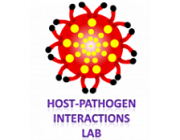Hagit Sason, Milgrom, Michal , Weiss, Aryeh M, Melamed-Book, Naomi , Balla, Tamas , Grinstein, Sergio , Backert, Steffen , Rosenshine, Ilan , and Aroeti, Benjamin . 2009.
“Enteropathogenic Escherichia Coli Subverts Phosphatidylinositol 4,5-Bisphosphate And Phosphatidylinositol 3,4,5-Trisphosphate Upon Epithelial Cell Infection”. Mol Biol Cell, 20, 1, Pp. 544-55. doi:10.1091/mbc.E08-05-0516.
Abstract Phosphatidylinositol 4,5-bisphosphate [PI(4,5)P(2)] and phosphatidylinositol 3,4,5-trisphosphate [PI(3,4,5)P(3)] are phosphoinositides (PIs) present in small amounts in the inner leaflet of the plasma membrane (PM) lipid bilayer of host target cells. They are thought to modulate the activity of proteins involved in enteropathogenic Escherichia coli (EPEC) infection. However, the role of PI(4,5)P(2) and PI(3,4,5)P(3) in EPEC pathogenesis remains obscure. Here we show that EPEC induces a transient PI(4,5)P(2) accumulation at bacterial infection sites. Simultaneous actin accumulation, likely involved in the construction of the actin-rich pedestal, is also observed at these sites. Acute PI(4,5)P(2) depletion partially diminishes EPEC adherence to the cell surface and actin pedestal formation. These findings are consistent with a bimodal role, whereby PI(4,5)P(2) contributes to EPEC association with the cell surface and to the maximal induction of actin pedestals. Finally, we show that EPEC induces PI(3,4,5)P(3) clustering at bacterial infection sites, in a translocated intimin receptor (Tir)-dependent manner. Tir phosphorylated on tyrosine 454, but not on tyrosine 474, forms complexes with an active phosphatidylinositol 3-kinase (PI3K), suggesting that PI3K recruited by Tir prompts the production of PI(3,4,5)P(3) beneath EPEC attachment sites. The functional significance of this event may be related to the ability of EPEC to modulate cell death and innate immunity.
Victor Yashunsky, Shimron, Simcha , Lirtsman, Vladislav , Weiss, Aryeh M, Melamed-Book, Naomi , Golosovsky, Michael , Davidov, Dan , and Aroeti, Benjamin . 2009.
“Real-Time Monitoring Of Transferrin-Induced Endocytic Vesicle Formation By Mid-Infrared Surface Plasmon Resonance”. Biophys J, 97, 4, Pp. 1003-12. doi:10.1016/j.bpj.2009.05.052.
Abstract We report on the application of surface plasmon resonance (SPR), based on Fourier transform infrared spectroscopy in the mid-infrared wavelength range, for real-time and label-free sensing of transferrin-induced endocytic processes in human melanoma cells. The evanescent field of the mid-infrared surface plasmon penetrates deep into the cell, allowing highly sensitive SPR measurements of dynamic processes occurring at significant cellular depths. We monitored in real-time, infrared reflectivity spectra in the SPR regime from living cells exposed to human transferrin (Tfn). We show that although fluorescence microscopy measures primarily Tfn accumulation in recycling endosomes located deep in the cell's cytoplasm, the SPR technique measures mainly Tfn-mediated formation of early endocytic organelles located in close proximity to the plasma membrane. Our SPR and fluorescence data are very well described by a kinetic model of Tfn endocytosis, suggested previously in similar cell systems. Hence, our SPR data provide further support to the rather controversial ability of Tfn to stimulate its own endocytosis. Our analysis also yields what we believe is novel information on the role of membrane cholesterol in modulating the kinetics of endocytic vesicle biogenesis and consumption.

